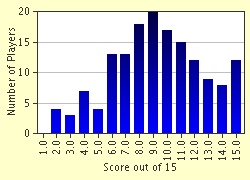Quiz Answer Key and Fun Facts
1. The title of the novel is taken from a melancholy song from one of Shakespeare's plays (a comedy, oddly enough). Which play is it from?
2. Christie had one major regret about this novel. What was it?
3. The novel begins with Elinor in the dock, listening to the prosecution's case against her. She thinks back to the incident that triggered the whole matter. What was the incident?
4. In addition to having had, apparently, the perfect opportunity to have poisoned Mary Gerrard, Elinor also had an excellent motive for the crime. Roddy, Elinor's fiancÚ, had fallen hopelessly in love with Mary, which led to the dissolution of their engagement. Did Mary return Roddy's feelings?
5. Elinor's aunt, Laura Welman, was planning to change her will to leave the bulk of her estate to Mary Gerrard.
6. Dr. Lord, Laura Welman's physician, suspected that her death was not due to natural causes. Why didn't he relate his suspicions to the police and order an autopsy?
7. Nurse Hopkins cunningly encourages Mary to make a will, leaving everything to her mother's sister Mary Riley (a.k.a Nurse Hopkins herself). Elinor happens upon the two as the will is being drawn up. What is her rather bizarre reaction upon being told that Mary is making out a will?
8. After Mary's murder and the subsequent arrest of Elinor Carlisle, Dr. Lord asks Hercule Poirot to investigate the crime. In his first conversation with Poirot, Lord mentions the murder of Benedict Farley, which Poirot had solved brilliantly. The Benedict Farley case was, in fact, the subject of one of Christie's short stories. Which one was it?
9. Nurse Hopkins shows Poirot a letter written by Mary's mother, Eliza Gerrard (nee Riley) revealing that Mary was really Mrs. Welman's daughter. To whom was this letter addressed?
10. In an interview with Poirot, Elinor admits that, while she was cutting the sandwiches on the day of the murder, she was thinking of which historical personage?
11. Ultimately, the ruthless Nurse Hopkins is undone by a trivial lie she told regarding a rosebush growing near the lodge. What was peculiar about this rosebush?
12. How was the morphine that killed Mary Gerrard administered?
13. What was significant about the fragment of the label found at the scene of the crime, which had come from a tube of hypodermic tablets?
14. The defense calls two witnesses who positively identify Nurse Hopkins as Mary Riley, whom they had formerly known in New Zealand. It develops that the New Zealand police had suspected Mary Riley of murdering two other people. Who were they?
15. In the final chapter of the novel, Poirot tells Peter Lord that Elinor's infatuation with Roddy Welman is a thing of the past, and encourages him to pursue Elinor himself. The last sentence of the novel, spoken by Poirot, is "She loved Roderick Welman. What of it? With you, she can be ________." (Fill in the missing word).
Source: Author
jouen58
This quiz was reviewed by FunTrivia editor
MotherGoose before going online.
Any errors found in FunTrivia content are routinely corrected through our feedback system.

